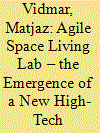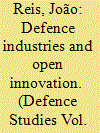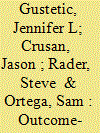|
|
|
Sort Order |
|
|
|
Items / Page
|
|
|
|
|
|
|
| Srl | Item |
| 1 |
ID:
169346


|
|
|
|
|
| Summary/Abstract |
The global space industry has recently seen a structural transformation through the emergence of ‘New Space’, i.e., a significant expansion of the development of smaller, cheaper, and more modular space-related products in services. One example of this expansion is the emergence of a world-leading cluster of New Space industry in Scotland (UK). Critically, this development is being pitched as a new approach to innovation ecosystem, which the players refer to as ‘Agile Space’, based on a consolidation of cross-sector competences within loose value chain integration. However, I argue, in particular, that the emergence of the Scottish New Space Sector is crucially linked to the Living Laboratories (Living Lab) conceptualisation of the innovation practices and processes within the Agile Space approach. Hence, this article maps the key features of the emergence and development of the New Space Industry in Scotland and analyses the key feature of the Agile Space Living Lab paradigm, before proposing a critical further research agenda suggesting several much-needed strands of enquiry.
|
|
|
|
|
|
|
|
|
|
|
|
|
|
|
|
| 2 |
ID:
186529


|
|
|
|
|
| Summary/Abstract |
The European Defence Industry is undergoing profound changes. Industrial activity is now operating on a quintuple helix innovation model with the deep involvement of universities and governments in innovation. In addition, military innovations are being transferred to civil society, with increasing attention paid to the environment. In the first stage, we report on the state-of-the-art of existing research using PRISMA protocol. The PRISMA technique is widely accepted by the academic community for its ability to discover concepts, ideas, and debates about the defence industry. In the second stage, we present a case study involving the Portuguese Defence Industry, for which multiple data collection sources were used to ensure triangulation and corroboration. The results show that, in the light of the quintuple helix innovation model, it was possible to bring applications from theoretical discussion to real life. Moreover, within the scope of the triple helix, it was possible to develop, produce and test military products, allowing to improve the military capacity of ground forces. In the future, ecological concerns will likely increase, so we suggest a greater focus on this area of research.
|
|
|
|
|
|
|
|
|
|
|
|
|
|
|
|
| 3 |
ID:
110314


|
|
|
| 4 |
ID:
142585


|
|
|
|
|
| Summary/Abstract |
In an increasingly connected and networked world, the National Aeronautics and Space Administration (NASA) recognizes the value of the public as a strategic partner in addressing some of our most pressing challenges. The agency is working to more effectively harness the expertise, ingenuity, and creativity of individual members of the public by enabling, accelerating, and scaling the use of open innovation approaches including prizes, challenges, and crowdsourcing. As NASA's use of open innovation tools to solve a variety of types of problems and advance of number of outcomes continues to grow, challenge design is also becoming more sophisticated as our expertise and capacity (personnel, platforms, and partners) grows and develops. NASA has recently pivoted from talking about the benefits of challenge-driven approaches, to the outcomes these types of activities yield. Challenge design should be informed by desired outcomes that align with NASA's mission. This paper provides several case studies of NASA open innovation activities and maps the outcomes of those activities to a successful set of outcomes that challenges can help drive alongside traditional tools such as contracts, grants and partnerships.
|
|
|
|
|
|
|
|
|
|
|
|
|
|
|
|
|
|
|
|
|